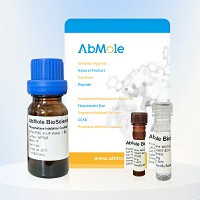
Species: Mouse
Expression system: E. coli
Purity: SDS-PAGE analysis > 97%, HPLC analysis > 97%
Endotoxin: protein content < 1 EU/μg by LAL method
Theoretical molecular weight: 8 kDa
Storage and stability: After receiving, the product remains stable at -70°C or -20°C for up to 6 months. After recombination, the product should be stable at 4°C for 1 week or -20°C for 3 months. Avoid repeated freeze-thaw cycles.
Bioactivity: Fully bioactive compared to the standard. The bioactivity measured by chemotactic bioassay of human peripheral blood monocytes was in the range of 50.0-100.0 ng/ mL. Sdf-1 α and SDF-1β cdna encode precursor proteins with 89 and 93 amino acid residues, respectively. Both SDF-1α and SDF-1β are encoded by a single gene and produced by alternate splicing. The two proteins are identical except that sdF-1 β carboxyl terminus contains four amino acid residues and SDF-1α is absent. Sdf-1 /PBSF is highly conserved between species, with only one amino acid substitution between mature human and mouse proteins. Sdf-1 /PBSF works via chemokine receptor CXCR4 and has been shown to act as a chemokine for T lymphocytes, monocytes, pre-B cells, and pre-B cells, but not neutrophils. Mice lacking SDF-1 or CXCR4 were found to have impaired B lymphogenesis, bone marrow formation, vascular development, cardiogenesis, and abnormal nerve cell migration and patterns in the central nervous system.
| Solubility (25°C) | Reconstitute the lyophilized powder in sterile distilled water or aqueous buffer containing 0.1 % BSA to a concentration of 0.1-1.0 mg/ml. |
| Storage |
Stable for up to 6 months at -70°C or -20°C. Upon reconstitution, the product should be stable for up to 1 week at 4°C or up to 3 months at -20°C. |
| Species | Mouse | Rat | Rabbit | Guinea pig | Hamster | Dog |
| Weight (kg) | 0.02 | 0.15 | 1.8 | 0.4 | 0.08 | 10 |
| Body Surface Area (m2) | 0.007 | 0.025 | 0.15 | 0.05 | 0.02 | 0.5 |
| Km factor | 3 | 6 | 12 | 8 | 5 | 20 |
| Animal A (mg/kg) = Animal B (mg/kg) multiplied by | Animal B Km |
| Animal A Km |
For example, to modify the dose of Compound A used for a mouse (20 mg/kg) to a dose based on the BSA for a rat, multiply 20 mg/kg by the Km factor for a mouse and then divide by the Km factor for a rat. This calculation results in a rat equivalent dose for Compound A of 10 mg/kg.
| Related Recombinant Proteins Products |
|---|
| Recombinant Mouse E-Selectin/CD62E Protein (HEK293)
E-selectin, also known as endothelial leukocyte adhesion molecule-1 (ELAM-1) and CD62E, is an inducible adhesion molecule that is expressed on the surfaces of stimulated vascular endothelial cells and is sometimes involved in cancer cell metastasis. |
| Recombinant Human DPP4/CD26 (Mammalian, C-6His)
DPP4/CD26 is a signal-anchor for type II membrane protein that belongs to the peptidase S9B family. DPP4/CD26 acts as a positive regulator of T-cell coactivation, by binding at least ADA, CAV1, IGF2R, and PTPRC. It’s binding to CAV1 and CARD11 induces T-cell proliferation and NF-kappa-B activation in a T-cell receptor/CD3-dependent manner. |
| Recombinant Human USP14 (E.coli, N-6His)
USP14 belongs to the ubiquitin-specific processing (USP) family which is a deubiquitinating enzyme (DUB) with His and Cys domains. USP14 acts also as a physiological inhibitor of endoplasmic reticulum-associated degradation (ERAD) under the non-stressed condition by inhibiting the degradation of unfolded endoplasmic reticulum proteins via interaction with ERN1. |
| Recombinant Human EpCAM/Trop-1 (Mammalian, C-Fc)
Epithelial Cell Adhesion Molecule (EpCAM) is a signal type I transmembrane glycoprotein. EpCAM plays a role in embryonic stem cells proliferation and differentiation; it up-regulates the expression of FABP5, MYC and Cyclin A and Cyclin E. It is highly and selectively expressed by undifferentiated embryonic stem cells. |
| Recombinant Human IL-36 gamma/IL-1 F9 Protein (E. coli, aa 18-169, His Tag)
The recombinant human IL1F9 consists of 168 amino acids and predicts a molecular mass of 19.1 KDa. A DNA sequence encoding the mature form of human IL1F9 (Ser18-Asp169) was expressed with a polyhistide tag at the N-terminus. |


Products are for research use only. Not for human use. We do not sell to patients.
© Copyright 2010-2023 AbMole BioScience. All Rights Reserved.
